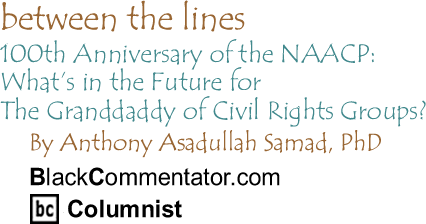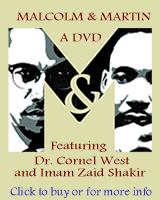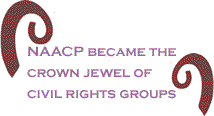
|
|||||||||||||||||||||||

|
|

Custom Search
|
|
 |
|
This week, the most venerable of civil rights organizations, the National
Association For The Advancement of Colored People, more commonly
known as the NAACP, turns one hundred years old. The organization was born out of what started as an effort on the part of 29 black men to address the increased public assaults and lynchings against black men at the turn of the 20th Century. The Post Reconstruction era brought a twenty year “Redemption Period” from 1877 to 1896 that sought to reverse the social and political equality gains of African Americans (then Negroes) in Reconstruction, as social behaviors of exclusion and separation became the cultural norms and ultimately, law, as the U.S. Supreme Court affirmed “Separate But Equal” as legal. This decision ushered in a 70 year period of de jure segregation that
came to be known as Jim Crow. It brought forth an open season on
blacks, targeting those most prone to “act white” (act equal and
defend their rights) in the “New Negro” era (blacks born after slavery
was abolished in 1865). Led by Scholar and sociologist, W.E.B. DuBois,
the meeting was so controversial that they held it on the Canadian
side of
This was the beginning of what became known as the NAACP. Its first twenty
five years (1909 to 1934) was solely dedicated to getting Congress
or the President (any President) to pass and sign into law, anti-lynching
legislation. However, stand alone anti-lynching legislation was
never passed in the history of these It was at this time, the organization changed strategies to engage in a 20 year battle to end Jim Crow, by hiring Howard Law School Dean, Charles Hamilton Houston, and one of his law students, Thurgood Marshall (five years later), who started the NAACP Legal Defense Fund in 1939 and argued dozens of cases over a 15 year period that culminated in five cases (in four states and the District of Columbia) being consolidated in one case that came to be known as Brown v. Board of Education. In winning the Brown decision that outlawed “Separate But Equal,” NAACP became the crown jewel of civil rights groups and the focus of the U.S. Government and state governments that sought to disband the organization and prosecute (intimidate) its members. The NAACP was disbanded in The uneasy alliance forged the first meaningful Civil Rights legislation in the 20th Century, the elimination of Jim Crow and the protection of voting rights. However, after the assassination of King, who had emerged as the central figure of the movement, and the rise of the pro-black radical movement (known as the “Black Power” movement), the NAACP lost its resonance in the movement.
Now when you asked what the NAACP does, nobody can tell you. As a past
NAACP branch president, I can say that (though nobody else will-but
they think it). In the last year, the NAACP decided to “go young,” hiring the youngest President in its history, 35 year old, Benjamin Jealous, a bright futuristic thinker with a global human rights advocacy focus. He recently announced it would also become the NAACP’s focus. Hmmmm. That’s futuristic thinking sho’ nuff for a two headed dinosaur that hasn’t found it way out of the 1980s. The NAACP does entertainment better than it does advocacy these days. Not quite the credentials we were looking for at the age of 100. In the age of Obama, talk of post-racialism and a widening equality gap, there is space for the NAACP to play in the advocacy arena. The problem is, it’s been 50 years since the NAACP was at the right place, at the right time, and therein lies its dilemma - being able to transition with the time. The question really is, what does the future hold for the NAACP, and can it get there in time to make a difference? You shiver at the very thought. Let’s hope so. Aside from that, Happy 100th Anniversary, NAACP. BlackCommentator.com Columnist, Dr. Anthony Asadullah Samad, is a national columnist, managing director of the Urban Issues Forum and author of Saving The Race: Empowerment Through Wisdom. His Website is AnthonySamad.com. Click here to contact Dr. Samad. |
|
Any BlackCommentator.com article may be re-printed so long as it is re-printed in its entirety and full credit given to the author and www.BlackCommentator.com. If the re-print is on the Internet we additionally request a link back to the original piece on our Website. Your comments are always welcome. eMail re-print notice
If you send us an eMail message we may publish all or part of it, unless you tell us it is not for publication. You may also request that we withhold your name. Thank you very much for your readership. |
|
| |
|
| February
12, 2009 Issue 311 |
|
| Executive Editor: Bill Fletcher, Jr. |
| Managing Editor: Nancy Littlefield |
| Publisher: Peter Gamble |
| Est. April 5, 2002 |
Printer Friendly Version
in resizeable plain
text format or pdf
format. |
| Frequently Asked Questions |
 |

|
 |
 |
 |
| |
| |





























 However,
once they returned to
However,
once they returned to 
 In
the Post Civil Rights Movement (1980s forward), the NAACP, except
for its Fairshare and ACT-SO programs, lost its standing in the
courts (after the Legal Defense Fund left the organization in the
late 1970s, sued and won the right to keep its name), lost its membership
ranks and lost its leadership focus (after Ben Hooks retired, the
NAACP has had five executive directors/President and three board
chairs in 15 years).
In
the Post Civil Rights Movement (1980s forward), the NAACP, except
for its Fairshare and ACT-SO programs, lost its standing in the
courts (after the Legal Defense Fund left the organization in the
late 1970s, sued and won the right to keep its name), lost its membership
ranks and lost its leadership focus (after Ben Hooks retired, the
NAACP has had five executive directors/President and three board
chairs in 15 years).







